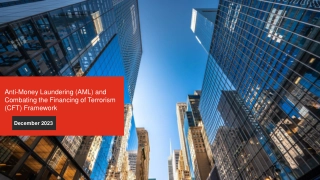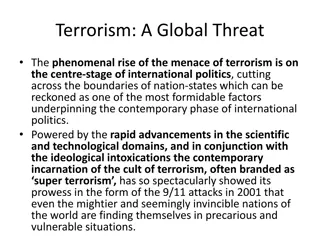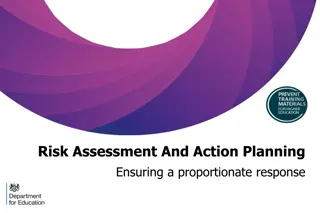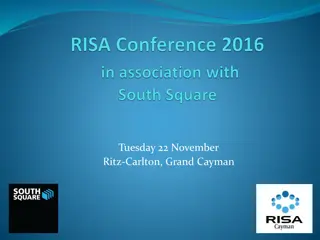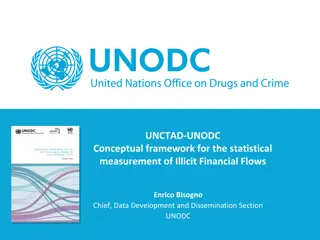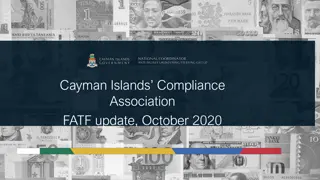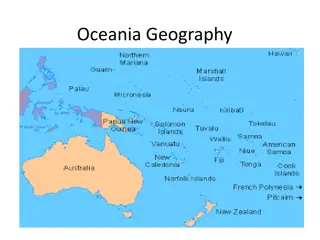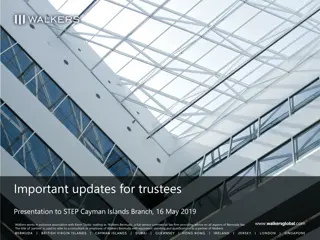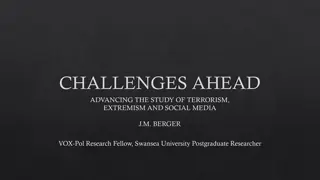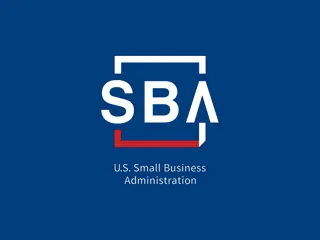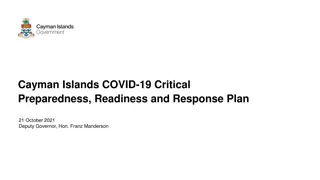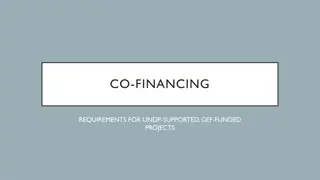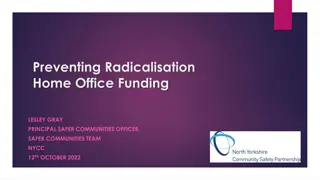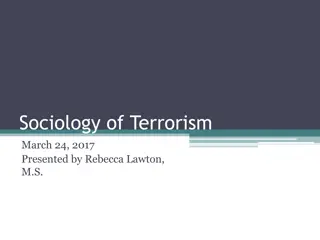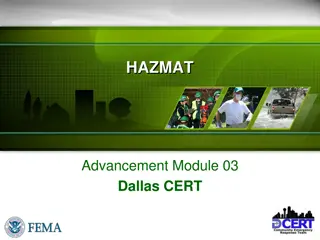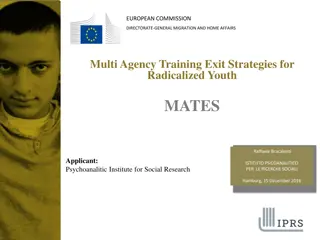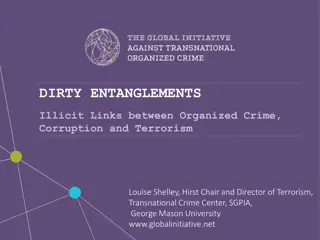Terrorism Financing Risk Assessment in Cayman Islands (February 2020)
The Terrorism Financing Risk Assessment in Cayman Islands, conducted in February 2020, analyzed data on cross-border fund flows, trade statistics, intelligence on terrorism financing, and more. The assessment identified high-risk jurisdictions and utilized the FATF's guidance to assess risks related to the collection, movement, and use of funds, with a focus on three typologies of movement. Measures were outlined to address terrorism financing risks.
Download Presentation

Please find below an Image/Link to download the presentation.
The content on the website is provided AS IS for your information and personal use only. It may not be sold, licensed, or shared on other websites without obtaining consent from the author. Download presentation by click this link. If you encounter any issues during the download, it is possible that the publisher has removed the file from their server.
E N D
Presentation Transcript
1 An overview of the Terrorism Financing Risk Assessment Cayman Islands, February 2020
2 Overview 1. Process and Methodology for Risk Assessment 2. Risk Areas: Collection, Movement and Use 3. Movement Typology A 4. Movement Typology B 5. Movement Typology C 6. Conclusion on Risk Assessment 7. Measures Taken to Address TF Risk 8. Domestic coordination and cooperation
3 The process: Working group participants: AMLU, FCU, FRA, ODPP, CIMA, DCI, ROC, MFS, SC, CBC Identification of high risk jurisdiction based on publically available information: Tier 1: Iraq, Afghanistan, Nigeria, Somalia, Syria, Pakistan, India, Yemen, Egypt, the Philippines Tier 2: Democratic Republic of Congo, Turkey, Libya, South Sudan, Central African Republic, Cameroon, Thailand, Sudan and Kenya
4 Data analysed included: Statistics on cross-border flows of funds from / to the Cayman Islands (SWIFT) 2014 2018 Trade statistics 2017 and 2018 SARs in relation to TF and higher risk countries Remittance statistics Intelligence involving TF / terrorism from other countries Investigations / prosecutions / international cooperation requests Private flight, private and cruise ship vessel logs, cash declaration information Demographic and work permit statistics Open source information on TF and terrorism involving the Cayman Islands
5 Methodology: Guided by FATFs Guidance July 2019 and Moneyval Risk Assessment Guide for IFCs: Financial Centers, like all jurisdictions, can only put in place effective measures to address TF if they fully understand their risks in this area . Considers three risks: Collection, Movement and Use of funds Assigns risk rating for each; Low, Medium Low, Medium, Medium High, High
6 Collection, Movement and Use: Use and collection: deemed low due mainly due to demography (and geography) Movement: 3 typologies; A)Transit: funds move through the Cayman Islands to support terrorism abroad B) Regulated Service Providers facilitate the movement, without funds entering the Cayman Islands C) Cayman legal entities are abused for TF purposes
7 Movement: Typology A transit outflows Between 2014 2018: 0.005% of total outflows from Cayman Islands went to tier 1 and 2 high risk jurisdictions. Of which: 77% went to tier 1 high risk countries (India, Philippines and Nigeria) Less than 5% went to Iraq, Pakistan and Egypt Less than 0.07% transferred to Yemen and Afghanistan No beneficiaries in Syria, Somalia, South Sudan, Sudan or the Central African Republic.
8 Movement: Typology A transit inflows Only 0.03% of all funds received by the Cayman Islands between 2014 and 2018 came from tier 1 and tier 2 high risk jurisdictions Tier 1: Primarily India, the Philippines and Pakistan Tier 2: Primarily received from Turkey, Kenya, Thailand. Linkages with Cameroon and DR Congo exist but less significant volume. No funds received from Somalia, Syria and Yemen.
9 Movement: Typology A transit - MSB data 2014 -2018 Relating to High Risk Jurisdictions Significant flows only to / from India and the Philippines Large migrant workforce in Cayman Islands Some limited flows to Kenya Demographic ties exist
10 Movement: Typology B - regulated service providers Analysis of STRs 2015 2018: 46 STRs related to tier 1 and tier 2 countries Most related to Movement Typology B Fact Pattern Regulated Service Providers facilitate the movement, without funds entering the Cayman Islands None resulted in investigation in the Cayman Islands Example: FBME bank: Holding company in Cayman Islands, serviced by a Cayman TCSP: Investigated by US for TF Cayman Islands holding company struck off company registry in 2016 after the Cayman Islands TCSP ended its relationship with the company.
11 Movement: Typology C Cayman Companies According to case studies, legal entities and arrangements are one of the most frequently used vehicles in illicit schemes. Risk of terrorist networks raising funds through legal entities (straw companies) using crowdfunding techniques. Large number of ICOs in Cayman Islands and the sums involved leads to risk of Cayman legal entities being used to facilitate the collection of funds. Cryptocurrencies: Currently literature suggests limited attractiveness for TF due to lack of anonymity but need to closely monitor
12 Conclusion on Movement Typologies A C Legal entities and regulated service providers are at forefront of the risk exposure (typologies B and C) Financial flows (typology A) through the Cayman Islands banking system to tier 1 and 2 high risk countries exist but are limited in value compared to total amounts and can be explained by demographics Risk of physical transportation of cash to / from the Cayman Islands for TF purposes is considered to be low.
13 Conclusion on Risk Assessment Collection or use of funds: Low risk Movement of funds: Medium risk Relative high volume of funds moved as an International Financial Centre: weighted more significantly Composite TF risk rating of medium
14 Measures Taken to Address TF Risk Movement of funds / regulated service providers: Enhancement of FI/TCSP Supervision New AML Division at CIMA Enhanced supervision of SIBL EPs (registered persons) DCI implementation of risk based supervisory engagement with DPMS and real estate Legal sector supervisor designated and commenced operations Typologies involving ICOs / virtual currencies, use of Cayman entities; VASPs legislation Prevention, investigation: Training: TF, TFS, Outreach to private sector on key results of TF Risk Assessment Establishment of Bureau of Financial Investigations within RCIPS focusing on cross border ML and TF Risk Assessment of NPO Sector and Supervision for NPOs with higher TF risk
16 National Coordination Team


